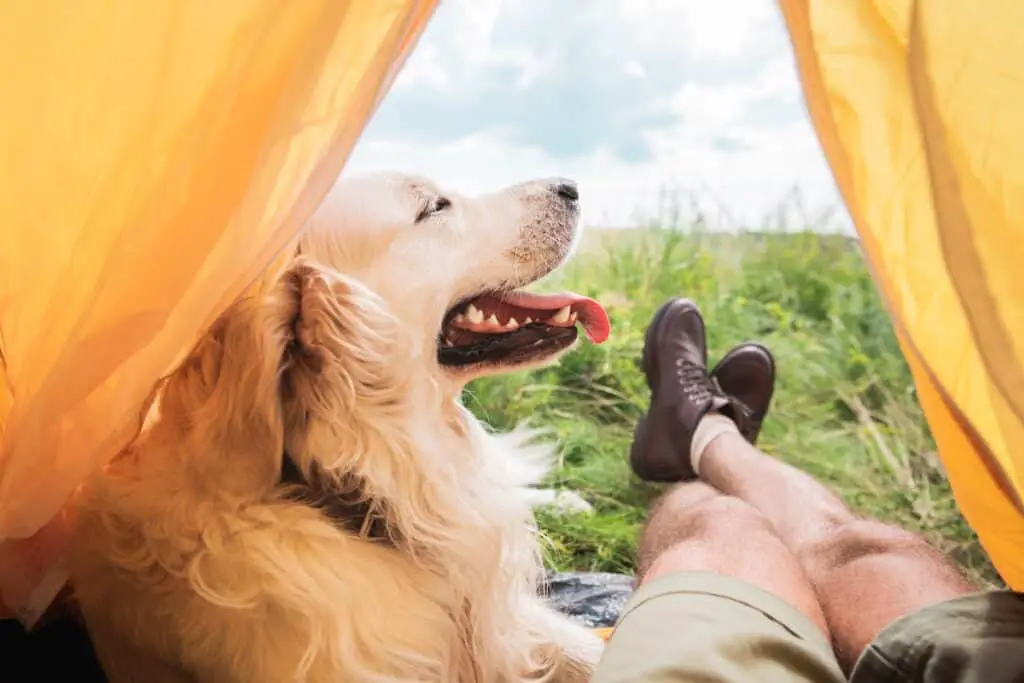Taking your dog camping for the first time can seem daunting. You want to make everyone has a fantastic time, including your pup, but you’re unsure where to begin. In this article we share our best tips for preparing for a successful first camping trip with your puppy.
Many people are under the impression that camping trips with their dogs are too complicated or risky, but it’s not the case. With some preparation and common sense tips, your dog’s first camping trip can be an enjoyable experience for everyone.
We’ve put together this handy guide, packed with tips for camping with dogs, when we were planning our first year of camping with our puppy, Charlie. Since then we’ve traveled all over the country with her (she’s now almost 3 years old). She is an amazing camper (except the night she woke us up barking because elk were hanging out in our campsite). This list has held as a great outline of how to get your puppy ready for adventure. I have added notes to the list as we’ve continued to train her.
We’ve links to some products that you might find useful in helping your puppy on its first camping trip. Some of those links are affiliate links, which means we may earn a small commission if you make a purchase.
So get ready to pack up your pup and enjoy a road trip with your dog.
Is Your Dog Ready to Go Camping?
Before you set off for your first big adventure with your furry friend, you first need to work out if your dog is campsite ready:
- Do they need to work on their doggy etiquette when around other pups?
- When you call them, do they run in the opposite direction?
- Do they bark at anything that moves?
There may be a few skills you and your furry friend need to brush up on before you can take them camping. Here are a few questions to ask yourself:
Can They Walk Calmly On A Leash?
It’s typically required for dogs to be on a leash in public areas, so it’s essential that they are comfortable walking on a leash before you go. If they’re not used to wearing a leash and the most common leash commands, you may have behavior problems at the campsite.
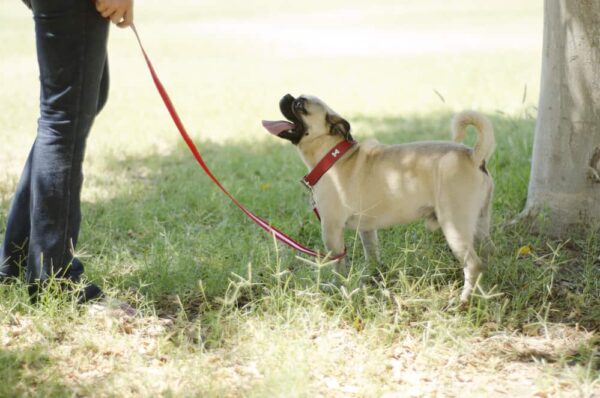
Do They Have Good Recall?
If your dog has selective hearing and doesn’t come when called, maybe they’re not ready to go just yet. Dogs can quickly become lost in unfamiliar surroundings, so they must be alert and responsive to your commands.
Controlling your dog with good recall skills will also stop them from wandering into tents and RVs and bothering your new campsite neighbors.
Can They Socialize With Other Dogs?
Dogs need to socialize peacefully with other pups for a positive camping experience. If your dog’s social skills are somewhat lacking, try taking them to a local dog park or doggy daycare to get used to other dogs.
Dogs that are aggressive or reactive around other dogs may need to work on their socialization skills with a professional trainer before attempting to take them with you.
Is Your Dog Used to a Lot of Exercise?
If you plan to do lots of hiking or enjoy longer walks while camping but your dog isn’t used to intense activity, start by gradually increasing their exercise levels in the weeks leading up to your trip. This practice will help them build up their stamina and avoid getting exhausted.
Always be aware of your furry friend’s limitations – remember, this is supposed to be a fun trip for both of you! We have tips for hiking with your puppy here.
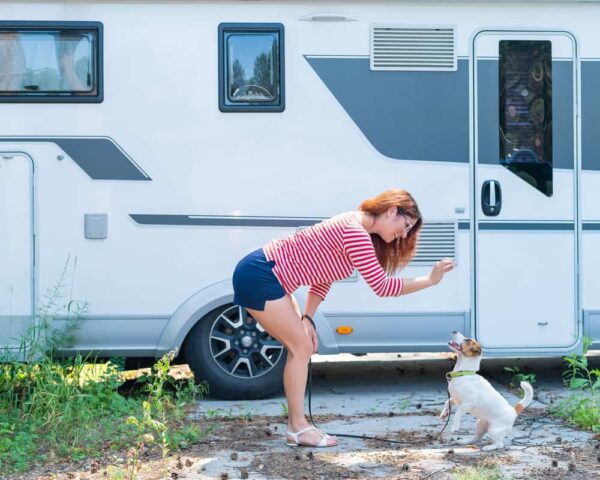
Have Reasonable Expectations When Taking Your Dog Camping for the First Time
Taking your dog camping for the first time can be an excellent experience for both of you, but it’s important to have reasonable expectations. Just like the rest of us, dogs are a work in progress. They will make mistakes. Your job is to protect your dogs and teach them how to enjoy camping.
For a successful first camping trip, dog owners must be patient and take things slowly.
In addition to the critical skill of Recall and Leash Walking, here are a few other commands that you can practice the first time you are camping with your dog. Mastering these will make future trips easier for both of you.
The Leave it Command – With so many new smells and sounds to explore on the campsite, your dog must know how to leave things alone when you tell them.
Work on the basics in training to help your dog’s behavior fit the camping lifestyle. Of course, keep plenty of dog treats handy as part of your reward system.
- Sit
- Lie down
- Stay
- Come
There will be so many new stimulants on your first camping trip with your dog that basic commands like these can be powerful tools to keep your dog safe. If they’re a bit rusty, you can find some great training techniques here.
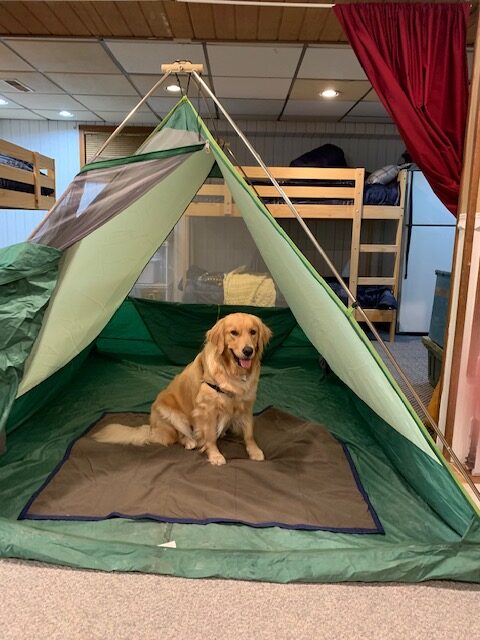
Practice Camping Before You Go
Doing a practice run in your backyard or basement before taking your dog camping for the first time is a great idea. We set up our tent in the basement an just sat in it with our dog for a few day. Hanging out inside with your dog will help them get used to it and show them that it’s nothing to fear.
If you’re RV camping, you can do a trial run by spending a night or two in your driveway or even take your furry friend for a drive. Let your pup hang out with you while you pack your RV for the trip. If your dog is a little anxious, reward them with lots of praise and snuggles.
Practicing like this will give your dog a chance to get used to their new surroundings and help them understand that it’s just another place to spend time with their best friend – you!
Campground Selection is Critical
When choosing a campground, there are a few things to take into consideration:
Select pet-friendly campgrounds. Not all campgrounds are dog friendly, so ask before booking. The good news is that most campgrounds understand that campers want to travel with their furry friends and offer pet-friendly facilities to make your stay easier and less stressful.
We’ve found campgrounds in National Parks to be very pet-friendly and Charlie has enjoyed camping in Glacier National Park, Crater Lake National Park and most of the California parks.
For example, you might find there are fenced-off areas specifically designed for dogs to park their owner safely on a bench, allowing them the freedom to socialize with other more interesting and hairier guests! Some campsites also include:
- Dog-friendly trails
- Doggie water stations
- Sprinklers to cool off
- Dog-safe ponds for swimming and splashing around
- Fire hydrants for that extra touch of luxury toileting
I also look for campsites that have less neighbors and less foot traffic to reduce distractions that might cause our dog to get anxious. I avoid the sites right next to the bathrooms and try to get on the edge of the loops with trees behind me instead of another camper.
Note that some campgrounds require dogs to have their vaccination records, so keep a copy handy. I keep a copy on my phone as well as a paper copy in our glove compartment.
Help Your Dog Get to Know His New Surroundings
One of the best ways to settle your dog into a new setting is to get them used to the sights and smells of the campsite before you even set up camp. If possible, take a walk around the site with your dog on a leash so that they can explore dog-friendly campsites at their own pace.
As you’re walking around, allow your dog to meet as many other dogs and other campers as possible. Be cautious, though, and never force your dog to say hello if they seem uncomfortable or scared.
When meeting other dogs, always ask the owner first if it’s okay for your pup to approach. Not all dogs enjoy the company of others, and some may even be aggressive. It’s always better to be safe than sorry.
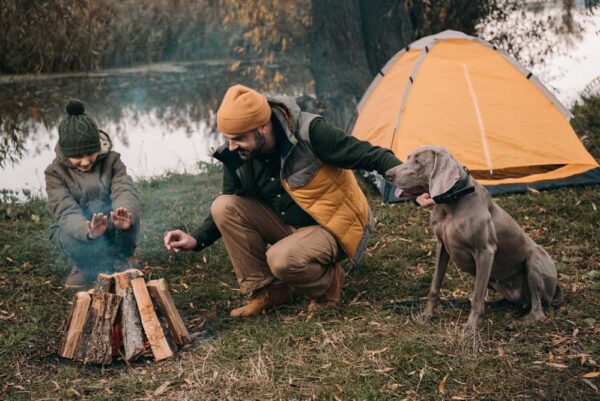
What to Do In Camp
You’ve set up camp. Now what?
Supervise Your Dog
As we mentioned earlier, dogs are very protective of their pack and always watch for danger. It’s a good idea to adopt this same attitude with your four-legged explorer and keep a close eye on them when you’re in camp.
Dogs aren’t accustomed to the new and unusual dangers found away from home. Your dog may not realize that a busy road or a deep hole in the ground could be hazardous. Not to mention the unfamiliar plants and mushrooms they may discover in the woods!
Even if your dog is well-behaved, it’s important not to leave them unsupervised at the campsite. Dogs can get into all sorts of trouble when left alone, including getting into food, chewing on things they’re not supposed to, and escaping and getting lost.
If you need to leave your campsite for any reason, make sure someone stays behind to watch your pup. Anything could go wrong in the 10 minutes it takes for you to make a quick trip to the bathrooms.
Bring Their Favorite Toys
A bored dog will find something to do, and it’s often not what you had in mind. To avoid this, bring your dog’s favorite toys to keep them entertained and burn off some of that excess energy.
Toys that are interactive and require some thinking, such as Kongs stuffed with treats or puzzle toys, are ideal for keeping your dog entertained. This will keep their minds active and occupied and make them less likely to make mischief. However make sure you have night time toys without squeakers because in that tight space you don’t want to be awaken by that annoying noise!
Bring Your Dog’s Crate
Puppies need a safe place to rest and nothing will feel more like home than their crate or kennel. I know you’ll think it will save you a ton of space to skip bringing it… but bring the crate anyway. There are so many new experiences when you are camping that your young dog will easily get overwhelmed. By allowing some crate time, they will settle down and relax making the trip better for everyone.
Training Routines
Dogs love routine and feel more secure when they know what’s expected. If you can, stick to your usual training routine while camping. Normalcy will help your dog feel settled and relaxed.
Don’t forget the treats! Dogs are far more likely to enjoy training if you remember to bring their favorite treat as a reward.
Keeping Your Dog On A Leash
Most campgrounds require a 6-foot leash. If you’re unsure about the campsite’s leash rules, ask a staff member for clarification.
Keeping your dog on a leash benefits your dog’s safety and is a courtesy to your fellow campers. Dogs are curious by nature, and it only takes a split second for them to get into trouble, get hurt or wander off and get lost. Consider that some people are afraid of dogs or don’t appreciate having dogs running around loose near children.
Should You Use a Tie-out in Camp?
Keeping your dog on a leash when in camp may not be practical. It’s nice to give your pup a little freedom while camping and free up your hands so you can relax or work.
In this case, you can use a tie-out to secure your dog to a fixed point. I usually find the picnic table is a very stable anchor source that keeps our puppy close to us and in the center of camp. Take care not to damage any trees or posts, and use a tie-out of good quality and fit for purpose. Ensure the tie-out is long enough for your dog to move around comfortably but not so long that your dog can reach any hazards.
For safety reasons, it’s a good idea to practice using a tie-out at home before going camping. It’s a great way to familiarize your dog with it, so they know what to expect and prevent them from becoming stressed, tangled up, or hurt.
However, never leave your dog alone at your campsite on a tie-out. It only takes a few seconds for a wild critter or a curious child to enter their space.
Don’t forget to check if using a tie-out first is okay, as some campgrounds have a strict 6-foot leash rule. We highly recommend the Knot-a-hitch from Ruffwear for a truly hardwearing and safe tie-out system if you’re considering purchasing one.
Camping Potty Breaks for Your Dog
Dogs don’t like to potty in their “home” area, and you don’t want them to anyway. So you should walk them to a safe spot to do their duty. Ask a staff member for advice if you’re unsure where the best place is for your dog to go to the toilet.
Always clean up after your dog’s poop and dispose of their waste properly. I always take more poop bags than I think we’ll need on a trip.
If you’re camping in a remote area, be prepared to carry their waste out when you leave, so make sure you have waste bags in your pack. Or, if you’re able to bury it, dig the hole at least six inches deep and fill it in afterward.
Plan for Your Dog to Get Dirty While Camping
No matter how well-behaved your dog is, they will get dirty while camping. Rain, mud, rivers, and lakes are all part of the camping experience, so be prepared for your dog to come home dirty and a bit whiffy.
Pack some old towels and doggy wet wipes to clean them off before jumping in the car or tent. After a long day of hiking and camping, your dog will appreciate a good wash, so don’t forget the shampoo!
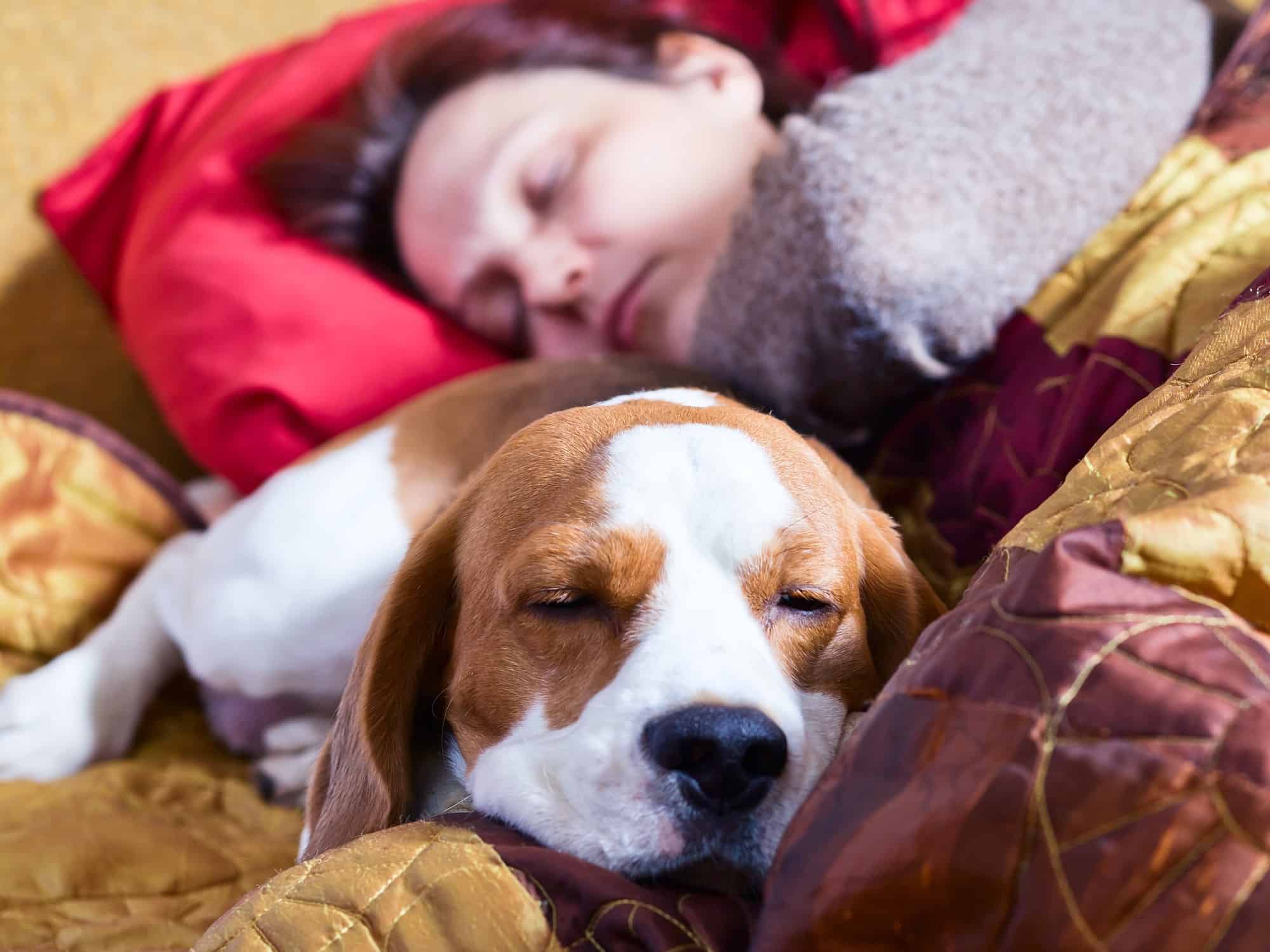
Where Should Your Dog Sleep on Her First Camping Trip?
Camping with dogs the first time creates a few challenges with finding the best way to ensure your dogs sleep through the night. Otherwise, you won’t get a good night’s rest either.
Keep Your Dog’s Sleeping Environment “Normal”
Dogs are creatures of habit and prefer sleeping in their own beds. Your dog also wants to feel like they’re part of the pack and not isolated from the family.
If your dog is used to sleeping in a crate or bed at home, bring it along when you go camping. This provides a familiar and comfortable place to sleep and will reduce their stress levels.
When camping with dogs, set your kennel or dog bed up in a space that seems close to routine. This probably means setting up their sleeping pad or kennel in your tent or RV. Or, if they usually kennel away from you, your vehicle might be the best kennel placement option for the night, provided it’s not too hot or cold. Just be sure to open a window so they can get some fresh air.
If your dog sleeps with you at home, he will be happy to snuggle between your sleeping bags. For cooler weather, you might even get your pup a sleeping bag of his own.
Whatever you do, don’t let your dog sleep outside under the stars by themselves. The local wild animals may pose a serious threat. It’s not all chipmunks and squirrels out there!
Consider a Bigger Tent
If you have a small tent, your dog may feel stressed from being cooped up, especially if you’re all packed in like sardines. If possible, consider upgrading to a bigger tent that will give your dog some more space to move around in.
Protect Your Tent Floor
Friends reminded us to take padding for the tent floor on our first dog camping trip. They use the interlocking kids flooring. We lay down a couple of old thick packing blankets. Either way, the padding on the floor protects your tent floor from those puppy toenails. And if your pup is not in a kennel, you’ll find without padding, the floor makes a crinkling noise every time your dog moves, which is not great for your sleep!
Keeping Your Dog from Barking During the Night
Dogs hear and smell so much more than we do. So when you are taking your dog camping for the first time, they are hyper-alert. And with all the new smells and sounds, they feel an uncontrollable urge to bark and protect their pack (i.e., you and your family).
When you consider that humans can only hear sound up to 20,000Hz, and dogs hear up to 47,000 – 67,000Hz, you can imagine how loud the snoring in the neighboring tent is for your dog!
Dog noses also have around 300 million olfactory receptors compared to our measly 6 million. The dog’s brain has 40 percent more geared to deciphering those smells.
So, it’s up to you to do everything you can to help your dog feel safe and secure so they don’t feel the need to bark.
Choose an Isolated Campsite
Finding dog-friendly campsites within your campground is most important, especially when tent camping. Choose a campsite situated somewhere quiet, and where road noise is limited. I like to try to grab a campsite out of the main traffic pattern, both vehicle and foot traffic. Stay away from the bathrooms, attracting middle-of-the-night walkers that will set your dog’s alert system off.
Being out of the way will reduce the stimulants that might cause your dog to bark. And if your dog does bark, the distance will reduce the impact on your neighbors.
If possible, schedule your first camping trip with your dog when the campground isn’t as busy. You can discover how your dog will react while not annoying too many neighbors.
Mask Unusual Sounds with White Noise
White noise is a great way to soothe your dog and drown out any strange sounds that may have your dog on edge, causing them to bark. Even before our first camping trip, I found the white noise app on my phone helpful in getting our puppy to settle down for the night when we were visiting family.
Another great source of white noise is a fan, especially in the summer when it serves the double duty of keeping air moving in the tent. We love this USB battery fan we picked up for our trip into the desert of Western Texas.
If your puppy is extra sensitive to outside noises and sounds, it’s worth investing in a battery-powered white noise machine. (We also use this one when our grandkids are napping in our noisy house!)
Take Your Dog for a Hike
Exploring the great outdoors with your furry friend by your side is a great way to burn off excess energy. And a tired dog will sleep a lot better!
But before you start your hike, ensure you’re familiar with the route and know what to expect.
- Be sure to bring plenty of water for both you and your dog.
- Bring snacks in case your journey takes longer than anticipated. Dogs burn a lot of calories when hiking.
- If the weather is hot, hike early in the morning or later in the evening to avoid the day’s heat.
- Check your dog’s paws for any thorns or injuries when you return to camp. Dog boots are a great option to protect tender dog paws on a rough trail.
- Make sure your dog is wearing a collar with ID tags, or invest in a GPS tracker, so you can locate them quickly if they do wander off.
- Remember to obey leash laws and practice good trail etiquette, such as cleaning up his dog poop.
You’ll find more tips for hiking with a puppy in this post. Some parks don’t allow dogs on trails, so always check that the hike is dog friendly before you go. And be aware that not all dogs are good candidates for hiking. If your dog is elderly, very young, or has health issues, it’s best to stick to shorter walks closer to camp.
Keeping Your Puppy Safe When Camping
Your dog’s safety should always be your number one priority when you take your dog camping for the first time. Here are some preventative tips you can do before you even leave for your trip:
Vaccinations
Be sure your dog is up to date on all their vaccinations. This precaution is vital if you’re camping in an area with a lot of wildlife or other dogs.
Carry your pet’s medical records with you, just in case. I keep a digital copy of an up-to-date list of vaccinations on my phone because it is easy to lose that piece of paper.
Pack First Aid Kit Essentials
Always plan and carry a first-aid kit with you in case your camping pup has an accident. You can purchase a prefilled kit that will take care of multiple dogs, like this pet first aid kit from ARCA. Or it’s easy to assemble your own first-aid kit with this list from the ASPCA.
ID Tags
Ensure your dog’s collar has ID secured so you can easily be reached if your dog wanders off. Also, make sure that they’re microchipped with up-to-date information.
Check for Ticks and Fleas
Ticks and fleas are more common in wooded areas, so check your dog for these pests after each walk and before bedtime. Tick and flea treatment before you go camping is critical to keep your dog safe. Several ways to prevent ticks and fleas from making your dog their home include tick and flea collars, spray, and spot-on treatments.
Ticks can attach themselves to your dog and cause serious health problems, so you need to remove them as soon as possible. Make sure you take a tick key or tweezers with you to camp, so you can remove the tick properly.

A Tracking Collar Provides Peace of Mind
Another way to keep your pup safe is by making sure you always know where they are, and a GPS tracking collar is a great way to do this. There are many different brands of tracking collars on the market. Some may have a more limited range if you are in a remote area, so you’ll need to do some research to find the one that best suits your needs.
We personally use and recommend the Fi collar. It’s fantastic for camping (and everyday use) because it tracks your dog’s location and monitors their activity level, health, and more.
We also put a rechargeable led collar with a bright light on Charlie after dark. That way, we can quickly see where she is hanging out.
Keep Your Dog Cool
The AKC reminds us that dogs don’t sweat. If you are camping with your dog in hot weather, be alert to any signs of overheating. However, the best defense is preventative action.
- Camp in the shade.
- Keep water accessible.
- For dogs with long thick coats, you may want to get them clipped or trimmed before you go camping. Not only will this will help keep them cool, but it will also prevent ticks and other insects from getting caught in their fur.
- That battery-powered fan we mentioned for white noise is perfect for keeping air moving during the day and cooling your pup.
Feeding Your Dog When Camping
When camping, your pup will use up a lot of energy running, playing, and exploring. This means they’ll need more dog food than usual, so make sure you pack enough for the trip. It’s always best to take more than you think you’ll need.
Bring their dog food and water bowls from home to make your camping canine companion feel at home on their first camping trip. This will reduce the anxiety of being in a new place and make mealtimes feel more familiar.
If you are feeding your dog outdoors, you must secure the bowls and dog food when you’re finished to avoid attracting wildlife to your campsite.
Keeping Your Dog Hydrated
One of the most important things to remember when camping with your dog is to keep them hydrated. Dogs can get dehydrated quickly, especially in hot weather, so have plenty of water for both you and your pup.
The best way to do this is to bring along a portable water bottle, fill it up whenever you have access to water, and keep a collapsible water bowlin your backpack to access it whenever you need it.
Final Thoughts
Taking your dog camping for the first time can be a great way to bond with your furry friend and create lasting memories. Preparing before you go is essential and ensuring your pup will be comfortable with the trip.
Also check out our article on Tips for a Successful Road Trip with your Dog for more ideas to make your puppy’s vacation one to remember.
Remember to follow the campsite rules, keep an eye on your pup at all times, and ensure they have plenty of food, water, exercise, and most of all, fun. With some planning, your dog’s first camping trip will be an adventure you’ll never forget!
